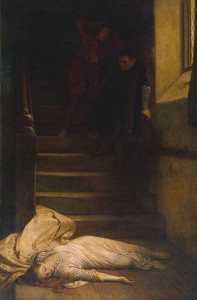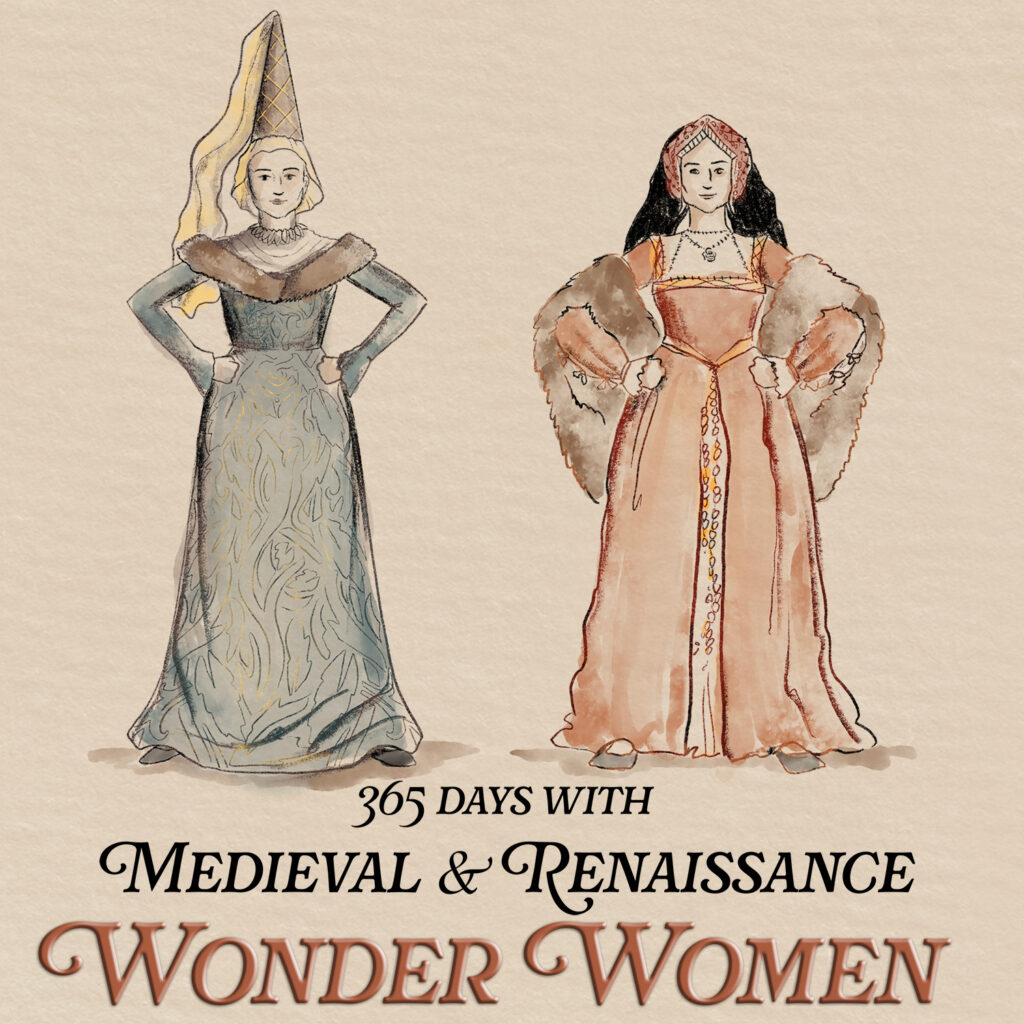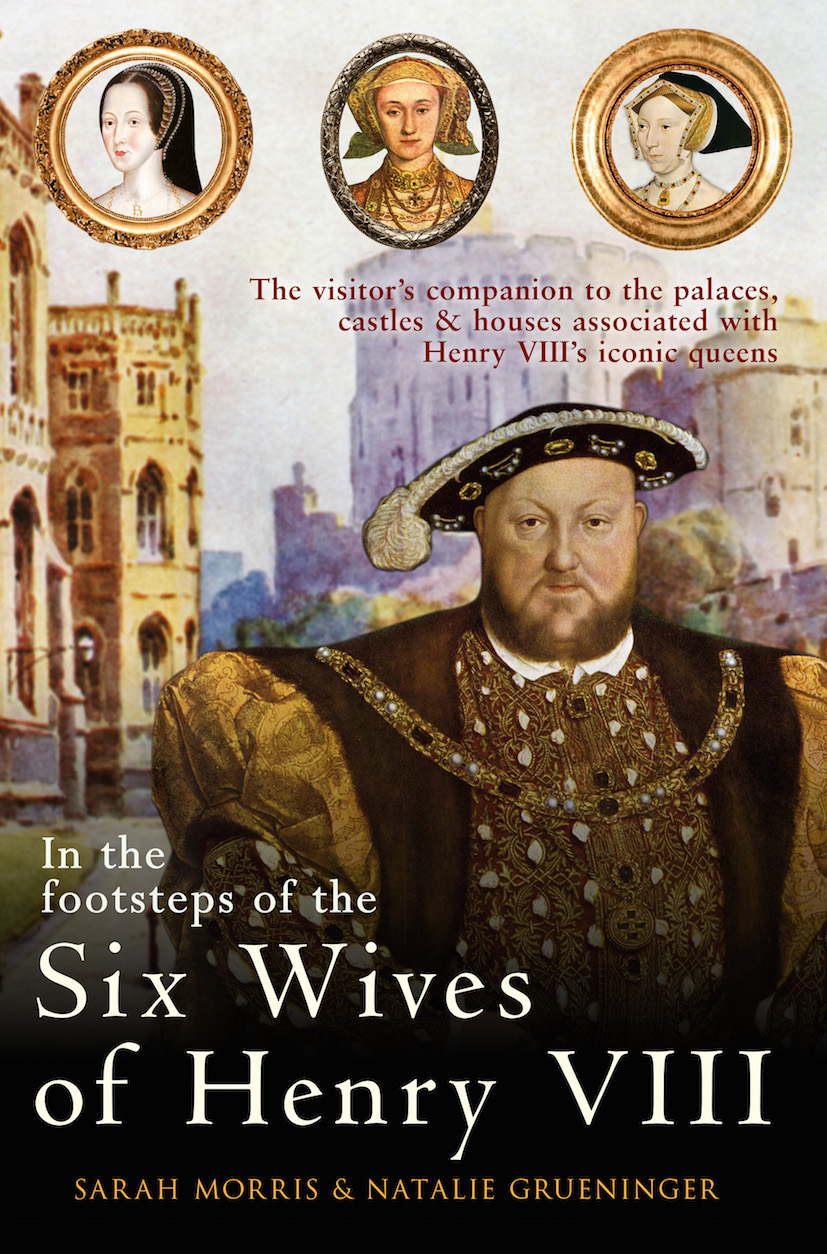I’m delighted to share with you the second article in our poll series called, “Tudor Tempest”. Novelist Nancy Bilyeau –author of The Crown and The Chalice — explores a question that has been hotly debated for five centuries. Was Robert Dudley involved in the death of his first wife, Amy Dudley?
Read Nancy’s article and then vote!
The death of Amy Dudley on Sept. 8, 1560, was a scandal and a mystery. More than five centuries later, we’re still not sure what happened to the 28-year-old wife of Lord Robert Dudley, the handsome courtier considered the favorite of the unmarried Queen Elizabeth. Lady Dudley was found dead at the bottom of a staircase just eight steps high, in a house empty of family, friends and servants. Amy was not the mistress of her own household; she was staying at Cumnor Place, which was a manor house rented by Sir Anthony Forster, a friend of her husband’s. When servants found her, Amy was dead but her headdress was neatly arranged around her head and there were no marks on her body.
This Timeline Presents the Major Relationships and Facts:
June 24, 1532: Robert Dudley, the fifth son of John Dudley, the future Duke of Northumberland, is born.
Sept 7, 1533: Princess Elizabeth, daughter of Henry VIII and Anne Boleyn, is born. Before she reached age three, Elizabeth’s mother is beheaded.
Jan. 31, 1547: Edward VI succeeds his father. Robert Dudley was brought up in Edward’s household, and there believed to have formed a friendship with Edward’s half-sister, Elizabeth. Dudley says much later: “I have known her better than any man alive since she was eight years old.”
June 4, 1550: Robert Dudley marries Amy Robsart, a Norfolk heiress. They are both teenagers; Amy is described later as “beautiful.” Princess Elizabeth attends the wedding.
March 8, 1554: Elizabeth is sent to the Tower of London under suspicion of treason in the Wyatt Rebellion, an uprising against her half-sister Mary. Robert Dudley is already in the Tower with other members of his family because of their support of the nine-day-queen Lady Jane Grey. Amy visits her husband in the Tower.
November 17, 1558: Elizabeth succeeds to the throne and Robert Dudley is made her Master of the Horse. From the beginning, observers comment on his closeness to the Queen. Amy does not accompany her husband to court but lives quietly in the country. They do not have children.
April 18, 1559: Spanish ambassador De Feria writes to the King of Spain: “During the last few days Lord Robert has come so much into favour, that he does what he likes with affairs and it is even said that Her Majesty visits him in his chamber day and night. People talk of this so freely that they go so far as to say that his wife has a malady in one of her breasts and the Queen is only waiting for her to die, to marry Lord Robert.”
April 25, 1559: The Venetian ambassador reports that Dudley was “a very handsome young man towards whom in various ways the Queen evinces such affection and inclination that many persons believe that his wife, who has been ailing some time, were perchance to die, the Queen might easily take him for her husband.”
Early summer 1559: Amy Dudley spends a month outside London with her husband, then she returns to the country. The couple never see each other again.
December 1559: Amy, her maid and several retainers move into Cumnor Place, near Oxford.
Early September 1560: In a dispatch dated Sept 11, De Quadra says that Secretary William Cecil in a confidential conversation within the past week said “he clearly saw the ruin of the state through Robert’s intimacy with the Queen, who surrendered all affairs to him and meant to marry him….Robert was thinking of killing his wife, who was publicly announced to be ill, though she was quite well and would take good care they did not poison her.”
Sept. 10, 1560: Dudley sent a letter to Thomas Blount, a kinsman: “Immediately upon your departing from me there came to me Bowes by whom I understand that my wife is dead, as he saith by a fall from a pair of stairs; little other understanding can I have of him. The greatness and suddenness of the misfortune doth so perplex me, until I do hear from you how the matter stands or how this evil doth light upon me, considering what the malicious world will bruit, as I can take no rest.”
Sept. 12, 1560: Queen Elizabeth ordered Dudley to retire from court while the enquiry is in progress. Dudley, frantic that people not blame him, says he wants investigations to continue “to the uttermost, as long as they lawfully may.”
September 1560: Investigations reveal that on the day of her death, Amy Dudley had insisted that all the servants in the house go to a fair. Earlier in the month, her maid said Amy was seen praying on her knees asking God “to deliver her from desperation.” Blount reported to Dudley, “Truly the tales I do hear of her make me thing that she had a strange mind in her.” The shallowness of the steps makes it extremely unlikely choice for suicide or for a place of murder. The inquiry jury returned a verdict of accidental death.
1567: Cecil writes in a letter that Dudley is still “infamed by his wife’s death.”
Sept 21, 1578: Dudley marries the queen’s cousin, Lettice Knollys, in secret. When the Queen learns of it, she is enraged and wounded.
September 4, 1588: Robert Dudley dies. When she received the news, Queen Elizabeth retreated behind a locked door until William Cecil ordered it broken down. Elizabeth marks Dudley’s final correspondence “His last letter.”
The death of Amy Robsart has intrigued me for years. I created a Pinterest board in honor of the anniversary of her death:
http://pinterest.com/tudorscribe/the-death-of-amy-robsart/
So what is your verdict. Was Robert Dudley involved in the death of his first wife? Yes or No?
























Those who are interested might want to read my article, which investigates Amy’s death and presents a likely cause of death.
http://www.conorbyrnex.blogspot.co.uk/2012/12/a-tudor-mystery-what-happened-to-amy.html
According to an article in the LA Times of Feb. 27, 2013, breast cancer is more aggressive in younger women than in older … and, in the 1950’s, Dr. Ian Aird noted that such a cancer could make Amy’s bones so brittle that even shallow steps could be fatal (the article below says that, statistically, the most dangerous stairs are those less than ten steps) For those who are interested in learning more, here is a two part article:
http://www.thehistoryfiles.com/amy-robsarts-death-part-i-accident-or-suicide/433/
http://www.thehistoryfiles.com/amy-robsarts-death-part-ii-the-improbability-of-murder/478/
Esther
Ah, don’t you just love a good mystery? I doubt Amy’s husband was involved with her death. Even if he wanted her out of the way, her suspicious death ruined any chance of Robert marrying Elizabeth I. Enemies of the queen and Dudley could have pushed Amy down the stairs. It’s a wonder more women didn’t fall down staircases tripping over those long skirts. It might not have been a steep flight of steps, but the outcome would depend on how one fell. Was her neck broken? I’ve heard conflicting accounts of her death.
Unfortunately there are many myths and misconceptions repeated in this post. If you allow I would like to list a few aspects.
1) The notion that the stairs were shallow or short is not a fact but is based on (hostile) rumour: the only source that mentions the stairs says: “falling down a pair of stairs, which was BY REPORT was but eight steps.” (This is from a draft chronicle of 1563 which recorded both facts and rumours; it is by an anonymous author who makes clear that he was an enemy of the Dudleys). It should be added that there is no medical reason to rule out a fatal accident on a stair of eight steps.
2) The claim that Amy Dudley’s headdress was intact only occurs in “Leicester’s Commonwealth”, a libel written 24 year after her death. This vicious work of propaganda contains many other wrong statements about her case which no historians takes seriously; the coroner’s report does not mention any details concerning Amy’s dress.
2) It is untrue that Amy Dudley was in a deserted house; she only sent away her own servants, not those of Forster and two other ladies residing in the house. Amy even had dinner with one of the ladies, Mrs. Odingsells.
3) It is equally untrue that Amy Dudley had no household of her own; she maintained about 10 servants and received the proceeds from the sheep business she had inherited from her parents.
4) William Cecil’s remarks to Quadra shortly before 11 September 1560 were almost certainly made AFTER Amy’s death and served his own selfish purposes; modern historians agree on this, and there is no particular reason to take them seriously.
http://allthingsrobertdudley.wordpress.com/category/amy-robsart/
Hi Christine, I am sure Nancy will be very interested to read the points you bring up. It is all about learning and sharing information after all. Thank you.
Amy’s murder might have been arranged by any one of Elizabeth’s counselors, as a way to prevent her from marrying Dudley. The suspicious nature of the death would make such a marriage pretty much politically impossible, at least for the short term.
I’ve also read things about this story that make me wonder if Amy was mentally ill, possibly depressed or clinically anorexic, and if that is why she was hidden away in the country, and had no children with Robert. The circs of the death don’t add up to suicide in a physically healthy individual, it wasn’t that much of a fall. But in someone physically debilitated by anorexia…perhaps. The condition was not known by name at the time, but anchorites in convents are believed to have suffered from a medeival variation of it. I believe there is evidence Tudor relative Arabella Stuart did, as well.
I personally think that Dudley was not involved in Amy’s death, firstly because he knew she was very ill, and it was only a matter of time before he became a widower, and secondly because any scandel attached to Amy being ‘disposed’ off would be uncovered by the very good spy net work that was about Elizabeth’s court and beyond, and therefore finish any chance he had to marry Elizabeth.
I feel the are two explanations to Amy’s death, the first which to me is the stronger one, as Joann says above, it was an act of conspiracy by some of those on Elizabeth’s council who hated and were threatened by Dudley, and the power Elizabeth’s love gave him, this would become greater still if they married, and in turn their power and position threatened. I also think her councilors wanted a foreign/policital marriage for Elizabeth. The second is that Amy was so ill and fragile that any fall, how ever small could have been fatal.
I also think, like Joann, that Amy was a little unstable, she was all but abandonded by Dudley because of his duties at court plus his close relationship with Elizabeth. Amy would have heard of this bond/love between them, and must have felt desolate as she and Dudley had married for love, this plus her illness would put most people on the edge of a break down.
It is all very sad, not one of these three people came out of this situation properly happy and fulfilled.
Cecil and Dudley were known enemies at court. No one wants Cecil as an enemy. My money is on him, as he had the greatest to lose should Robert Dudley marry the Queen. Amy’s death cast a shadow on Dudley that scared QE1 enough to give her much food for thought concerning marriage. If Amy was sick, and QE1 was already having an affair with her Robin, why kill her? Robert really had no motive. Neither did Elizabeth. Cecil had motive. To alienate Robert from court, and to discourage any marriage talk between Elizabeth and Robert. QE1 handled the scandal much better than her cousin Marie, who after her husband’s death, marries the prime suspect. We can look at Cecil there as well.
Cecil is a strong contender in my book too, when I mentioned the Council members, Walsingham another, her ‘spymaster’. Can I ask out of curiosity what you meant about Cecil’s involvement with Mary QofS marriage to Bothwell? sounds intriguing…
Amy’s death was truly death by misadventure, in one of two ways.
* She did, indeed, fall down the stairs, suffering fatal injury.
Or
* Given the state of her mind, at the time, she cast herself down the stairs, intending self harm, thereby gaining the attention and concern of the errant Robert. Tragically, the consequences of this act, were greater than she had imagined.
The second account is more plausible and compelling. It is clear that Amy had planned a course of action, which necessitated the sending away of her servitors, to ensure that she would not be observed.
Once she was alone in the house, it was a simple matter of carrying out her plan.
Alas, the outcome was not what she intended.